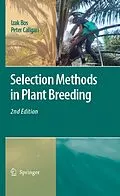Written for plant breeders, researchers and post-graduate students, this book provides a comprehensive review of the methods and underlying theoretical foundations used for selection in plant breeding programmes. The authors review basic elements of population and quantitative genetic theory, and consider in a unique way the tackling of the problems presented by soil heterogeneity and intergenotypic competition when selecting quantitative characters.
The efficacy of different methods with regard to developing new varieties of crops are discussed for different modes of reproduction.
This work provides a sound basis for informed decision making within the process of a selection programme.
Zusammenfassung
Selection procedures used in plant breeding have gradually developed over a very long time span, in fact since settled agriculture was ?rst undertaken. Nowadays these procedures range from very simple mass selection methods, sometimes applied in an ine?ective way, to indirect trait selection based on molecular markers. The procedures di?er in costs as well as in genetic - ciency.Incontrasttothegenetice?ciency,costsdependonthelocalconditions encountered by the breeder. The genetic progress per unit of money invested varies consequently from site to site. This book considers consequently only the genetic e?ciency, i.e. the rate of progress to be expected when applying a certain selection procedure. Ifabreederhasacertainbreedinggoalinmind,aselectionprocedureshould be chosen. A wise choice requires a wellfounded opinion about the response to be expected from any procedure that might be applied. Such an opinion should preferably be based on the most appropriate model when considering the crop and the trait (or traits) to be improved. Sometimes little knowledge is available about the genetic control of expression of the trait(s). This applies particularly in the case of quantitative variation in the traits. It is, therefore, important to be familiar with methods for the elucidation of the inheritance of the traits of interest. This means, in fact, that the breeder should be able to develop population genetic and quantitative genetic models that describe the observed mode of inheritance as satisfactorily as possible.
Inhalt
Population Genetic Effects of Cross-fertilization.- Population Genetic Effects of Inbreeding.- Assortative Mating and Disassortative Mating.- Population Genetic Effect of Selection with regard to Sex Expression.- Selection with Regard to a Trait with Qualitative Variation.- Random Variation of Allele Frequencies.- Components of the Phenotypic Value of Traits with Quantitative Variation.- Effects of the Mode of Reproduction on the Expected Genotypic Value.- Effects of the Mode of Reproduction on the Genetic Variance.- Applications of Quantitative Genetic Theory in Plant Breeding.- Selection for Several Traits.- Genotype × Environment Interaction.- Selection with Regard to a Trait with Quantitative Variation.- Reduction of the Detrimental Effect of Allocompetition on the Efficiency of Selection.- Optimizing the Evaluation of Candidates by means of Plots.- Causes of the Low Efficiency of Selection.- The Optimum Generation to Start Selection for Yield of a Self-Fertilizing Crop.- Experimental Designs for the Evaluation of Candidate Varieties.
Titel
Selection Methods in Plant Breeding
Autor
EAN
9781402063701
ISBN
978-1-4020-6370-1
Format
E-Book (pdf)
Hersteller
Herausgeber
Genre
Veröffentlichung
26.10.2007
Digitaler Kopierschutz
Wasserzeichen
Dateigrösse
5.14 MB
Anzahl Seiten
461
Jahr
2007
Untertitel
Englisch
Auflage
2nd ed. 2008
Unerwartete Verzögerung
Ups, ein Fehler ist aufgetreten. Bitte versuchen Sie es später noch einmal.
